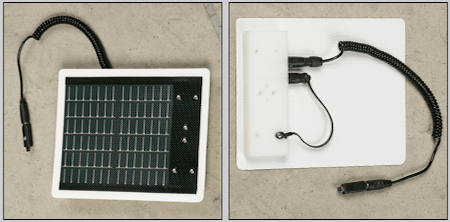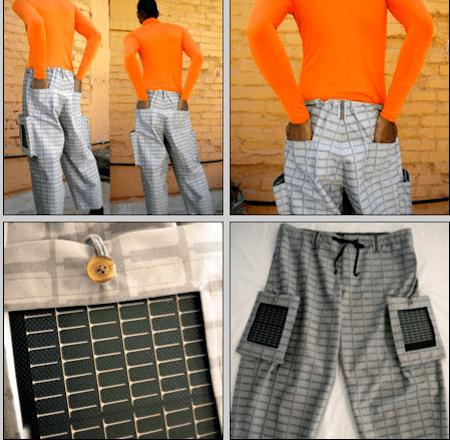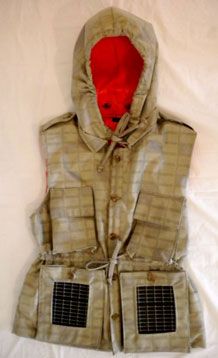We recently had the pleasure of chatting with Sandra Garratt, the design director of Los Angeles-based clothing company Silvr Lining, which combines sustainable and natural materials with renewable energy technology to create a new breed of modern clothing. Silvr Lining’s three collections feature modern, tech-based approaches to fashion while retaining the traditional ideas of form and function, and pay particular attention to the ethics and ecological consciousness of the materials used. The most obviously eco-conscious is her GO Collection, which integrates solar panels into actual clothing.
Garratt returned to California from New York with the desire to create a new kind of clothing company, one that not only reflected the people and culture of southern California, but one that combined high-performance materials with all-natural, organic, and animal-friendly ones. Garratt describes this choice as being a product of society’s becoming increasingly dependent on technology, while becoming ever more aware of the need to tread lightly and live sustainably. To that end, she created Silvr Lining.
The company was said to be created during the worst of California’s 2008 recession, and during a time where energy shortages were becoming a real concern. While others might have shied away from starting a business during such a time, Garratt saw her products and philosophy as a “silver lining,” a glimmer of hope for a brighter future.

In California, Garratt teamed up with Douglas Holmes, an electrical engineer looking for an opportunity to stretch his creative muscles. Together, they ended up creating Silvr Lining’s GO Collection, a line of urban sportswear that integrates solar panels that allow wearers to charge mobile devices while out and about. The sun is a huge part of life in southern California, Garratt says, and so integrating into fashion as well as technology seemed like the next logical step.
The GO Collection features a vest, two jackets, and a pair of cargo pants equipped with polymer solar panels. The panels have an attached power pack that can be hooked up to mobile devices to provide a charge. They simply slip into the garments’ pockets, are protected from the elements by a clear patch, and can be removed easily to allow for washing (unlike a certain solar bikini). The panels themselves can be wiped with a cloth for cleaning. Garratt decided on Ultrasuede for the clothing itself, which is made from recycled polyesters and is completely animal friendly.
For her other collections, Garratt prefers natural fibers, but the reclaimed nature of this fabric speaks to her philosophies of sustainability, as she is constantly considering the father-reaching implications of the materials she uses. Even the panels were an experiment in material reduction, as they were designed to be as minimal as possible.

The jackets, vest and pants are unisex, cut loose and casual, but have drawstrings and belts to create, if desired, a more shapely silhouette. “Most of our customers are women,” Garratt explains, “and women are more likely to wear men’s clothing than men are to wear women’s.
It’s kind of a weird stigma,” she adds with a laugh, “but there it is.” The collection comes in a variety of colors, ranging from bright, vibrant shades of orange and magenta to delicate greens, blues and earth tones. Noting that “they’re the colors of southern California,” some of the fabrics also sport a minimalist check pattern, which Garratt explains was taken directly from the pattern made by the circuitry of the panels.
“I think it’s inevitable that solar-powered clothing will become more popular, especially as technology continues to integrate itself further into areas like fashion and design,” Garratt says. She sees the future of solar clothing as becoming, “smaller, tighter and closer,” meaning that relatively bulky panels might one day give way to solar technology integrated into textiles themselves.

So far, the response has been good. Each item is made to order, and since the GO Collection pieces come with two solar packs each, the prices can be a bit daunting to the casual shopper (the cargo pants, for example, cost over $900). However, Silvr Lining has gotten some good press, with clothing from all three lines being featured on the HBO drama Concussion, and catching the eye of Black Eyed Peas frontman Will.i.am and actress Alicia Silverstone. “We’ve had a wonderful response,” Garratt says. “People are really curious.”
And it goes beyond the realm of fashion and into the realm of necessity, too. Garratt sees clothing with built-in power supplies as being a practical solution to emergencies, such as natural disasters where steady power might not be available. In the wake of the 2011 earthquake in Japan, Fukushima rescue workers used the Utility Vest and the Backup Power Pack as a much-needed power source.

Fashion and clothing design might not seem like the next immediate step in renewable energy technology, but technology and fashion actually share a long and close history. “Technology affects agriculture and manufacturing,” Garratt says. “Some of the earliest things to be manufactured on a large scale were textiles, so technology definitely influences fashion.”